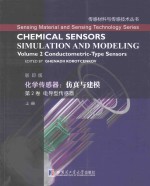

化学传感器:仿真与建模 第2卷 电导型传感器 上 英文影印版PDF电子书下载
- 电子书积分:11 积分如何计算积分?
- 作 者:(摩尔)科瑞特森科韦主编
- 出 版 社:哈尔滨:哈尔滨工业大学出版社
- 出版年份:2015
- ISBN:7560349022
- 页数:260 页
1 NUMERICAL SIMULATION OF ELECTRICAL RESPONSES TO GASES IN ADVANCED STRUCTURES&A.?etkus 1
1 Introduction 1
2 Analytic and Numeric Modeling 3
2.1 Basic Equations 3
2.2 Analytical Approaches 7
2.3 Numerical Simulations 15
2.4 Verification of Models 22
3 Resistive Sensors 28
3.1 Introductory Remarks 28
3.2 Polycrystalline Films 29
3.3 Nanostructured Films 34
3.4 Conductive Polymer Layers 38
3.5 Molecular Structures 40
4 Concluding Comments 43
References 44
2 Co-ADSORPTION PROCESSES AND QUANTUM MECHANICAL MODELING OF GAS-SENSING EFFECTS&J.-J.Velasco-Vélez 51
1 Introduction 51
2 Solid-Gas Interaction 55
2.1 Adsorption 55
2.2 Chemisorption 57
2.3 Electronic Transitions in Chemisorption 65
2.4 Chemisorption in Equilibrium,"Wolkenstein"Isotherm 67
2.5 Reaction Time 71
2.6 Charge Transfer Model(CTM) 73
3 Co-adsorption 79
3.1 Quantum Model 79
3.2 Statistical Model 81
3.3 Adsorption Time 83
4 Discussion 84
5 Summary 90
6 Nomenclature 92
Dedication 93
Acknowledgment 93
References 94
3 NANOSENSORS:A PLATFORM TO MODEL THE SENSING MECHANISMS IN METAL OXIDES&F.Hernandez-Ramirez J.D.Prades A.Cirera 97
1 Introduction 97
2 Toward a Better Description of Gas-Sensing Mechanisms in Metal Oxides:Oxygen Diffusion in Tin Dioxide Nanowires 100
2.1 Description of Oxygen Sensing Using Diffusion 105
2.2 Summary 107
3 Toward a Systematic Understanding of Photo-Activated Gas Sensors 108
3.1 Experimental Background 109
3.2 Theoretical Model of the Photo-Activated Response to Oxidizing Gases(NO2) 112
3.3 Comparison with Experiments 116
3.4 Other Target Gases 119
3.5 Summary 119
4 Conclusions 120
Acknowledgments 120
References 120
4 SURFACE STATE MODELS FOR CONDUCTANCE RESPONSE OF METAL OXIDE GAS SENSORS DURING THERMAL TRANSIENTS &A.Fort M.Mugnaini S.Rocchi V.Vignoli 127
1 Introduction 127
2 Surface-State-Based Models of Resistive Chemical Sensors 129
2.1 Depleted Surface 135
2.2 Enhanced Surface 141
3 Building a Chemical-Physical Sensor Model:From the Chemistry to the Resistance Variations 143
3.1 The Mechanism of Conduction in the Film:Effect of the Film Structure 143
3.2 Selection of a Model for Surface Potential Barrier Height as a Function of the Surface Charge:Solution of the Poisson Equation 146
3.3 Selection of a Model for the Evolution of the Surface Charge as a Function of the Surface Chemical Reactions 151
4 Surface State-Based Models for Chemical Resistive Sensors:Different Assumptions and Points of View 155
5 Developing a Treatable Gray Model from the Physical-Chemical Model 156
5.1 The Intrinsic Model 157
5.2 The Extrinsic Model:Contributions from Oxygen and Reducing Gas 159
5.3 Effects of Water Vapor 161
6 Conclusions 168
Nomenclature 169
References 170
5 CONDUCTANCE TRANSIENT ANALYSES OF METAL OXIDE GAS SENSORS ON THE EXAMPLE OF SPINEL FERRITE GAS SENSORS&K.Mukherjee S.B.Majumder 177
1 Introduction 177
2 Salient Features of Gas-Solid Interaction during Gas Sensing 178
3 Experimental 181
4 Modeling the Conductance Transients during Response and Recovery 182
4.1 Derivation of Response and Recovery Conductance Transients Based on Langmuir Adsorption Isotherm 184
4.2 Nonlinear Fitting of Response and Recovery Transients 187
4.3 Variation of Response and Recovery Time Constants with Sensor Operating Temperature 189
4.4 Variation of the Estimated Fitted Parameters with Test Gas Concentration:Addressing the Selectivity Issue 193
5 Characteristic Features Observed in Resistance Transients 196
5.1 Investigations on Irreversible and Reversible Gas Sensing in Oxide Gas Sensors 198
5.2 Periodic Undulation of the Resistance Transients during Response and Recovery 211
5.3 Spikelike Features in Resistance Transients 218
6 Summary and Conclusions 222
7 Appendix 223
7.1 Solution of Eq.(5.36) 223
7.2 Solution of Eq.(5.42) 224
8 Nomenclature 226
Acknowledgment 228
References 228
6 MODEL OF THERMAL TRANSIENT RESPONSE OF SEMICONDUCTOR GAS SENSORS&Akira Fujimoto 233
1 Introduction 233
2 Improvement in Selectivitv of the Semiconductor Gas Sensor Using Transient Response 234
3 Model of Thermal Transient Response of Semiconductor Gas Sensors 236
3.1 Transient Response of Semiconductor Gas Sensors 236
3.2 Thermal Transient Response of Semiconductor Gas Sensors 237
3.3 Physical and Chemical Processes in the Semiconductor Gas Sensor Under Transient Response 238
4 Modeling of Gas Sensor Processes 239
4.1 Heat Conduction Processes 239
4.2 Chemical Reaction Processes 242
4.3 Diffusion Processes 243
4.4 Sensor Output 244
5 Calculation MethOds 245
5.1 Heat Conduction 245
5.2 Gas Concentrations on the Sensor Surface 246
6 Calculated Transient Responses of Gas Sensors 247
6.1 Temperature Change on the Sensor Surface 247
6.2 Concentration Change of Substance in the Vicinity of the Sensor Surface 249
6.3 Comparison to Experimental Results 250
7 Application of the Model of Transient Response 251
7.1 Transient Responses Under Heating with Various Waveforms 251
7.2 Activation Energy Dependence of Transient Response 253
8 Conclusions 257
References 258
- 《微笑 影印本》N.达列基作 1947
- 《金丝髪 侦探小说 影印本》格离痕著 1914
- 《戊戌六君子遗集 影印本 上》谭嗣同撰 2019
- 《物联网中的传感器》葛卫清著 2019
- 《大数据建模方法》张平文,戴文渊,黄晶编著 2019
- 《抽象 推理 建模》杨明媚著 2019
- 《CATIA 软件建模与CAA二次开发》胡毕富,吴约旺 2018
- 《光纤传感与结构健康监测技术》杜彦良著 2019
- 《深入浅出Ruby 影印版》Jay McGavren 2017
- 《方程组实数解的几何方法 影印版》Frank Sottile 2018
